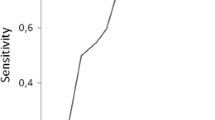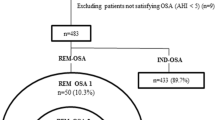Abstract
Purpose
Isolated sleep paralysis (ISP) is a rapid eye movement (REM) sleep parasomnia and has a special meaning in Chinese population. Worsening of obstructive sleep apnea (OSA) occurs especially during REM sleep. The relationship between ISP and OSA is unclear. The aim of this study was to investigate the impact of ISP on sleep and life quality in Chinese-Taiwanese OSA patients.
Methods
We recruited 107 OSA patients diagnosed by polysomnography (PSG) in Southern Taiwan. ISP was evaluated by self-reported sleep questionnaire. We used Chinese version of Epworth Sleepiness Scale (ESS), Pittsburgh Sleep Quality Index (PSQI), and Short-Form 36 (SF36) to evaluate daytime sleepiness, nocturnal sleep quality, and health-related quality of life, respectively for OSA patients. Student’s t-test was used to compare PSG parameters, ESS, PSQI, physical and mental component of SF-36 (P-SF36 and M-SF36) between OSA patients with and without ISP. Stepwise multiple regression was used to find out the factors independently associated with ESS, PSQI, P-SF36, and M-SF36.
Results
Forty-one of 107 patients (38.3%) had ISP. It showed no significant difference in PSG parameters between OSA patients with and without ISP. OSA patients with ISP had significantly higher ESS (P = 0.010), higher PSQI (P = 0.007), lower P-SF36 (P = 0.020), and lower M-SF36 (P = 0.001) than those without ISP. ISP was an independent factor associated with ESS (P = 0.017), PSQI (P = 0.001), and M-SF36 (P = 0.030) after adjusting for other confounding variables.
Conclusions
ISP was independently associated with excessive daytime sleepiness, worse sleep quality, and impaired mental health-related quality of life in Chinese-Taiwanese OSA patients.
Similar content being viewed by others
Abbreviations
- AHI:
-
Apnea-hypopnea index
- ArI:
-
Arousal index
- BMI:
-
Body mass index
- ESS:
-
Epworth Sleepiness Scale
- ISP:
-
Isolated sleep paralysis
- M-SF36:
-
Mental component of SF-36
- OSA:
-
Obstructive sleep apnea
- P-SF36:
-
Physical component of SF-36
- PSG:
-
Polysomnography
- PSQI:
-
Pittsburgh sleep quality index
- REM:
-
Rapid eye movement
- SF36:
-
Short-form 36
- SpO2:
-
Average pulse oxyhemoglobin saturation
References
American Academy of Sleep Medicine. (2005). The international classification of sleep disorders, diagnostic and coding manual (2nd ed.). Westchester, IL: American Academy of Sleep Medicine.
Ramsawh, H. J., Raffa, S. D., White, K. S., & Barlow, D. H. (2008). Risk factors for isolated sleep paralysis in an African American sample: A preliminary study. Behavior Therapy, 39(4), 386–397.
Takeuchi, T., Miyasita, A., Sasaki, Y., Inugami, M., & Fukuda, K. (1992). Isolated sleep paralysis elicited by sleep interruption. Sleep, 15(3), 217–225.
Smith, P. M., Brown, D., & Mellman, T. A. (2008). Sleep paralysis and sleep duration. Journal of the National Medical Association, 100(10), 1207–1208.
Bell, C. C., Dixie-Bell, D. D., & Thompson, B. (1986). Panic attacks: Relationship to isolated sleep paralysis. The American Journal of Psychiatry, 143(11), 1484.
Otto, M. W., Simon, N. M., Powers, M., Hinton, D., Zalta, A. K., & Pollack, M. H. (2006). Rates of isolated sleep paralysis in outpatients with anxiety disorders. Journal of Anxiety Disorders, 20(5), 687–693.
Hinton, D. E., Pich, V., Chhean, D., Pollack, M., & McNally, R. J. (2005). Sleep paralysis among Cambodian refugees: Association with PTSD diagnosis and severity. Depression and Anxiety, 22(2), 47–51.
Findley, L. J., Wilhoit, S. C., & Suratt, P. M. (1985). Apnea duration and hypoxemia during REM sleep in patients with obstructive sleep apnea. Chest, 87(4), 432–436.
Horner, R. L. (2008). Pathophysiology of obstructive sleep apnea. Journal of Cardiopulmonary Rehabilitation and Prevention, 28(5), 289–298.
Iranzo, A., & Santamaria, J. (2005). Severe obstructive sleep apnea/hypopnea mimicking REM sleep behavior disorder. Sleep, 28(2), 203–206.
Somers, V. K., Dyken, M. E., Clary, M. P., & Abboud, F. M. (1995). Sympathetic neural mechanisms in obstructive sleep apnea. The Journal of Clinical Investigation, 96(4), 1897–1904.
De Jong, J. T. (2005). Cultural variation in the clinical presentation of sleep paralysis. Transcultural Psychiatry, 42(1), 78–92.
Jiménez-Genchi, A., Avila-Rodríguez, V. M., Sánchez-Rojas, F., Terrez, B. E., & Nenclares-Portocarrero, A. (2009). Sleep paralysis in adolescents: The ‘a dead body climbed on top of me’ phenomenon in Mexico. Psychiatry and Clinical Neurosciences, 63(4), 546–549.
Kompanje, E. J. (2008). ‘The devil lay upon her and held her down’. Hypnagogic hallucinations and sleep paralysis described by the Dutch physician Isbrand van Diemerbroeck (1609–1674) in 1664. Journal of Sleep Research, 17(4), 464–467.
Wing, Y. K., Lee, S. T., & Chen, C. N. (1994). Sleep paralysis in Chinese: Ghost oppression phenomenon in Hong Kong. Sleep, 17(7), 609–613.
Szklo-Coxe, M., Young, T., Finn, L., & Mignot, E. (2007). Depression: Relationships to sleep paralysis and other sleep disturbances in a community sample. Journal of Sleep Research, 16(3), 297–312.
Wing, Y. K., Chiu, H., Leung, T., & Ng, J. (1999). Sleep paralysis in the elderly. Journal of Sleep Research, 8(2), 151–155.
Al Lawati, N. M., Patel, S. R., & Ayas, N. T. (2009). Epidemiology, risk factors, and consequences of obstructive sleep apnea and short sleep duration. Progress in Cardiovascular Diseases, 51(4), 285–293.
Baldwin, C. M., Griffith, K. A., Nieto, F. J., O’Connor, G. T., Walsleben, J. A., & Redline, S. (2001). The association of sleep-disordered breathing and sleep symptoms with quality of life in the sleep heart health study. Sleep, 24(1), 96–105.
Young, T., Peppard, P. E., & Gottlieb, D. J. (2002). Epidemiology of obstructive sleep apnea: A population health perspective. American Journal of Respiratory and Critical Care Medicine, 165(9), 1217–1239.
Rechtschaffen, A., & Kales, A. (1968). A manual of standardized terminology, technique and scoring system from sleep stages of human subjects. Washington, DC: Public Health Service, Government Printing Office.
American Academy of Sleep Medicine Task Force. (1999). Sleep-related breathing disorders in adults: Recommendations for syndrome definition and measurement techniques in clinical research. The report of an American academy of sleep medicine task force. Sleep, 22(5), 667–689.
Chen, N. H., Johns, M. W., Li, H. Y., Chu, C. C., Liang, S. C., Shu, Y. H., et al. (2002). Validation of a Chinese version of the Epworth sleepiness scale. Quality of Life Research, 11(8), 817–821.
Tsai, P. S., Wang, S. Y., Wang, M. Y., Su, C. T., Yang, T. T., Huang, C. J., et al. (2005). Psychometric evaluation of the Chinese version of the Pittsburgh sleep quality index (CPSQI) in primary insomnia and control subjects. Quality of Life Research, 14(80), 1943–1952.
Cheung, Y. B., Machin, D., Fong, K. Y., Thio, S. T., & Thumboo, J. (2005). Discriminative ability of the short-form 36 health survey: A tale of two versions. Quality of Life Research, 14(2), 555–559.
Sansa, G., Iranzo, A., & Santamaria, J. (2009). Obstructive sleep apnea in narcolepsy. Sleep Medicine. doi:10.1016/j.sleep.2009.02.009.
Lavie, P., & Peled, R. (1987). Narcolepsy is a rare disease in Israel. Sleep, 10(6), 608–609.
Young, T., Palta, M., Dempsey, J., Skatrud, J., Weber, S., & Badr, S. (1993). The occurrence of sleep-disordered breathing among middle-aged adults. The New England Journal of Medicine, 328(17), 1230–1235.
Wenner, J. B., Cheema, R., & Ayas, N. T. (2009). Clinical manifestations and consequences of obstructive sleep apnea. Journal of Cardiopulmonary Rehabilitation and Prevention, 29(2), 76–83.
Rakel, R. E. (2009). Clinical and societal consequences of obstructive sleep apnea and excessive daytime sleepiness. Postgraduate Medicine, 121(1), 86–95.
Saunamäki, T., & Jehkonen, M. (2007). Depression and anxiety in obstructive sleep apnea syndrome: A review. Acta Neurologica Scandinavica, 116(5), 277–288.
Scheltens, P., Visscher, F., Van Keimpema, A. R., Lindeboom, J., Taphoorn, M. J., & Wolters, E. C. (1991). Sleep apnea syndrome presenting with cognitive impairment. Neurology, 41(1), 155–156.
Gottlieb, D. J., Whitney, C. W., Bonekat, W. H., Iber, C., James, G. D., Lebowitz, M., et al. (1999). Relation of sleepiness to respiratory disturbance index: The sleep heart health study. American Journal of Respiratory and Critical Care Medicine, 159(2), 502–507.
Veasey, S. C. (2006). Obstructive sleep apnea: Re-evaluating our index of severity. Sleep Medicine, 7(1), 5–6.
Feige, B., Al-Shajlawi, A., Nissen, C., Voderholzer, U., Hornyak, M., Spiegelhalder, K., et al. (2008). Does REM sleep contribute to subjective wake time in primary insomnia? A comparison of polysomnographic and subjective sleep in 100 patients. Journal of Sleep Research, 17(2), 180–190.
Martin, S. E., Wraith, P. K., Deary, I. J., & Douglas, N. J. (1997). The effect of nonvisible sleep fragmentation on daytime function. American Journal of Respiratory and Critical Care Medicine, 155(5), 1596–1601.
Cheyne, J. A., Newby-Clark, I. R., & Rueffer, S. D. (1999). Relations among hypnagogic and hypnopompic experiences associated with sleep paralysis. Journal of Sleep Research, 8(4), 313–317.
Lee, Y. J. (1995). Sleep disorders in Chinese culture: Experiences from a study of insomnia in Taiwan. Psychiatry and Clinical Neurosciences, 49(2), 103–106.
Verma, A., Radtke, R. A., VanLandingham, K. E., King, J. H., & Husain, A. M. (2001). Slow wave sleep rebound and REM rebound following the first night of treatment with CPAP for sleep apnea: Correlation with subjective improvement in sleep quality. Sleep Medicine, 2(3), 215–223.
Acknowledgments
The authors gratefully appreciated Miss Yen-Ju Chuang, Fu-Huei Tsai, and Huei-En Cheng in the sleep center of Kaohsiung Medical University Hospital for their kindly assistance in data collection.
Conflict of interest
The authors declare no conflict of interest.
Author information
Authors and Affiliations
Corresponding author
Rights and permissions
About this article
Cite this article
Hsieh, SW., Lai, CL., Liu, CK. et al. Isolated sleep paralysis linked to impaired nocturnal sleep quality and health-related quality of life in Chinese-Taiwanese patients with obstructive sleep apnea. Qual Life Res 19, 1265–1272 (2010). https://doi.org/10.1007/s11136-010-9695-4
Accepted:
Published:
Issue Date:
DOI: https://doi.org/10.1007/s11136-010-9695-4




